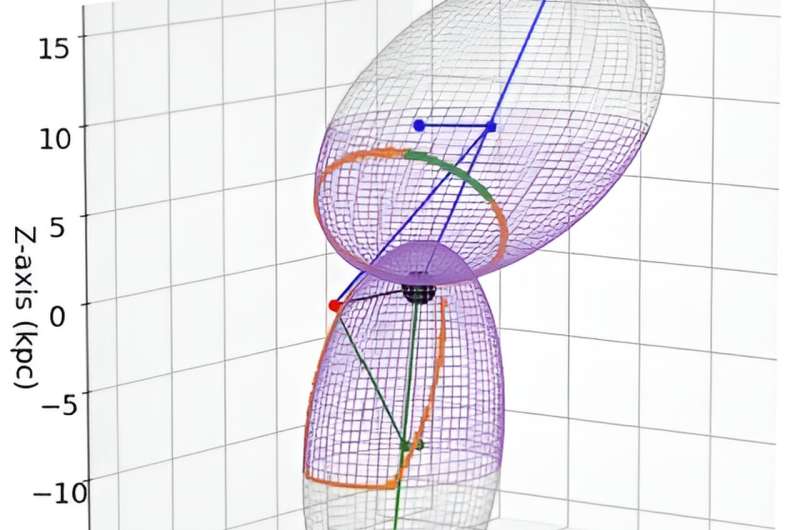In 2020, astronomers discovered a large hourglass-shaped structure in or near the center of our Milky Way galaxy. Dubbed “eROSITA bubbles,” there have been a few different hypotheses proposed to explain their precise nature. Now, a research team of scientists from China and Europe has constructed a high-resolution map of the region and found evidence that two of the most prominent features are not independent.
The eROSITA bubbles are seen as two-dimensional structures first detected by the eROSITA X-ray telescope that is on-board the Russian-German Spectrum-X-Gamma high-energy astrophysics space observatory sent aloft in 2019. They were notably similar in shape to the “Fermi bubbles” bulging out of the galactic center, discovered a decade earlier.
While the two Fermi bubbles were observed by detecting the gamma-ray and X-ray radiation they emit, the eROSITA bubbles were viewed as soft X-rays—highly energetic photons but with less energy than the X-rays used to image bones and much less energetic than gamma-rays.
The eROSITA bubbles are larger and more energetic overall than the Fermi bubbles, with quasi-circular lobes above and below the plane of the Milky Way, with two prominent features in the northern bubble: the North Polar Spur (NPS) and the Lotus Petal Cloud (LPC). On a two-dimensional X-ray map, these appear as two separate features, and they could be two distinct three-dimensional structures that by chance make up a two-dimensional bubble.
There have been two contradictory hypotheses to explain the eROSITA bubbles: either a 10,000 parsec-scale pair of giant bubbles blown by the Galactic center or a 100 parsec-scale structure in the region of the sun, coincidently located in the direction of the galactic center. (One parsec is 3.26 light-years.) The three-dimensional structure of the eROSITA bubbles is unknown; as two-dimensional, they appear as possibly the shadow of some other phenomenon.
“The energy involved in these two pictures differ by three to four orders of magnitude,” said Teng Liu, an astronomer at the University of Science and Technology of China in Hefei and lead author of the new study. “Thus, the solution has important consequences on the structure and history of the Milky Way.”
While astronomers have been unable to determine the distance to the X-ray emissions of the eROSITA bubble, they have measured the distance to dusty clouds that are part of the Milky Way. An earlier study led by Liu did find three isolated, dusty clouds at a distance of 500 to 800 parsecs, whose shape perfectly matches the X-ray shadows on the eROSITA bubbles, implying that the bubbles are more distant still. A shock front emitting polarized radio waves connects the North Polar Spur and Lotus Pedal Cloud.
That work also found that the outer border of the northern eROSITA bubble can be easily explained as a skewed three-dimensional model rooted at the galactic center and concluded that the scale of the eROSITA bubbles is about 10,000 parsecs, established at the galactic center.

To settle this matter of perspective, Liu and his teammates avoided analyzing the main body of the eROSITA bubbles. They focused on the question of whether the bubbles are a giant, distant bubble or a small structure near the sun. Instead of quantitative calculations “we simply pick up a few morphological features by eye,” said Liu, “whose existence makes a strong point to answer the question.”
In particular, from the projected shape of the three-dimensional dust clouds, it was possible to conclude that the NPS and LPC were distant, at least 1,000 parsecs away. Radio emission arcs were found in the dark region between these two features (“dark” meaning an absence of X-rays) and were attributed to the shock wave of the bubble’s front. Matching the outer border of the NPS and LPC provided a way to determine the northern bubble’s border.
This definition of the border can easily be described as a tangent to a line-of-sight of the three-dimensional cup model rooted in the galactic center. From this, the group concluded that the NPS and LPC were not independent, distant features but made up of a single, giant bubble. They determined that the northern eROSITA bubble is most likely the 10,000-parsec bubble with its root at the galactic center, blown by energy injection.
The border of the southern bubble is not as cleanly defined as the northern bubble, due to fainter X-ray emissions and some complicated features seen in the radio spectrum, it seems more elongated and less inclined than the northern bubble. Hence, it cannot be determined if the southern “cup” mentioned above is open or if it truly closes off into a bubble.
The relative simplicity of the visual methodology used shows that, Liu said, “To solve a problem, what one needs is not necessarily a doctor’s degree, but an idea.”
More information:
Teng 腾 Liu 刘 et al, Morphological Evidence for the eROSITA Bubbles Being Giant and Distant Structures, The Astrophysical Journal Letters (2024). DOI: 10.3847/2041-8213/ad47e0
© 2024 Science X Network
Citation:
The Milky Way’s eROSITA bubbles are large and distant (2024, June 29)
retrieved 29 June 2024
from
This document is subject to copyright. Apart from any fair dealing for the purpose of private study or research, no
part may be reproduced without the written permission. The content is provided for information purposes only.